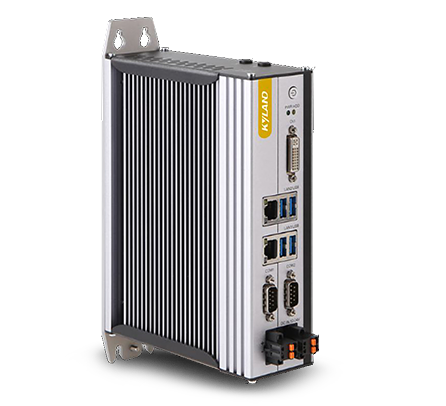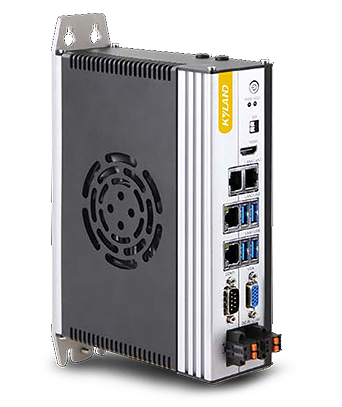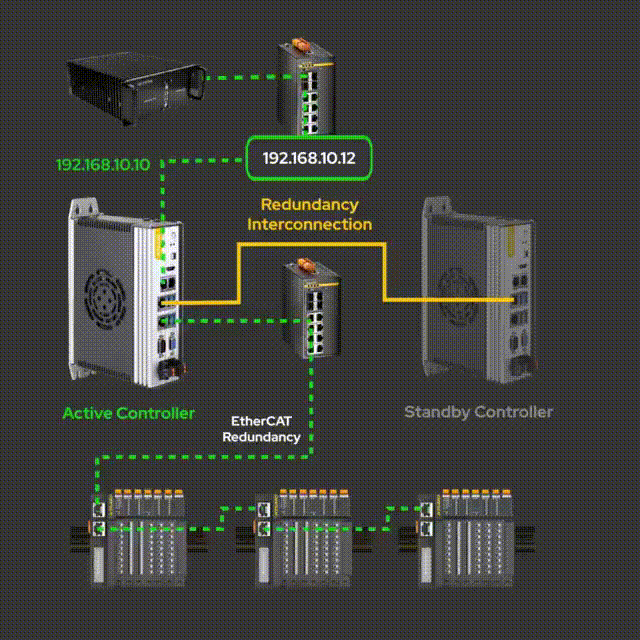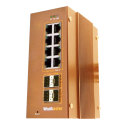
Programmable controllers KYAC311 and KYAC323 (generalized as KYAC) from Kyland are a reliable solution for motion control, creation of machine vision systems and for general automation systems. Both series have high performance and reliability, but there are slight differences in their hardware, which will be described below.
KYAC311
The KYAC311 series are compact and powerful controllers designed to handle high-load and demanding network environments. They have a fanless design and a reliable aluminum profile, and the working environment temperature can be from -20 to +60 degrees, so this solution can be used in projects with an unfavorable environment and air pollution.

Key features of KYAC311 include:
- Processor: Intel® Celeron J1900, 2.0GHz, 4 cores / 4 threads, 2MB L2 cache
- RAM: up to 8 GB DDR4
- Built-in memory: 128 GB SSD
- Network interfaces: 2 ports 10/100/1000Base-T
- Expansion slots: 1 full-size miniPCIe slot
KYAC311 are ideal for use in motion control systems.
KYAC323
The KYAC323 series is an improved and more powerful series, which is equipped with processors from the Intel Core I3/I5/I7 family. Since the TDP (Thermal Design Power) is 6.5 times higher than the KYAC311, active cooling is used here. Due to the higher operating speed, the system jitter for these models is 25 microseconds versus 35 for the KYAC311.
Key features of KYAC323 include:

- Processor: Intel Core I3-8100/I5-6400/I7-8700
- RAM: 8/16/32 GB DDR4
- Built-in memory: 128/256/512 GB SSD
- Network interfaces: 4 ports 10/100/1000Base-T
- Expansion slots: 2 full-size miniPCIe slots
KYAC323 controllers are ideal for use in machine vision systems as well as general industrial automation systems.
The main differences between the KYAC311 and KYAC323 series can be seen in the table below:
| Model name | KYAC311 | KYAC323 |
|---|---|---|
| CPU | Celeron J1900 | Intel® Core™ i3/i5/i7 |
| RAM | 8 GB DDR4 max | 32 GB DDR4 max |
| Network interfaces | 2 10/100/1000Base-T ports | 4 10/100/1000Base-T ports |
| miniPCIe slots | 1 full-size | 2 full-size |
| COM ports | 2x RS-232/485 | 1x RS-232/485 |
| Video interfaces | DVI-D | VGA, HDMI |
| Protocol support | EtherCAT, EtherNet/IP, OPC UA, ModbusTCP, OPC UA | |
| OS and runtime | Windows 10, Codesys RTE 3.5.18 | |
| Power requirements | 12-24 Vdc | |
Controller programming
KYAC controllers can be programmed in a variety of environments, including Python, C++, and Java. However, the main development environment is CODESYS. Models within the series differ from each other not only in their hardware, but also in their built-in modules, which allow you to select solutions for a specific application. Specific model names contain letters at the end by which you can tell which module is preinstalled:
- If the model name contains “SM” (SoftMotion), then this controller has a built-in SMC_Basic library, which complies with the PLC open certification standard (parts 1, 2). It can control the master-slave motion of one axis or two axes (electronic cam and gear).
- The presence of “CN” (CNC + Robotic) indicates that the SMC_CNC and SMC_Robotic libraries based on the SMC_Basic library have been added to the software, supporting applications for CNC and robots. With their help, you can implement the development of CNC numerical control systems and the development of groups of robot axes.
- TW (Target & Web Visu) means an integrated visual editor that allows you to create professional visual interfaces directly in the development environment. TargetVisu displays the interface on a connected display, while WebVisu supports viewing the interface in a web browser.
Below is a list of supported functions for each part of software:
SM (SoftMotion):
- SM (SoftMotion): Spot Motion, Step Motion, Position Compare Trigger, Position Capture, High Speed Motion, Home Position Return, Electronic Gear, Gap Capture, Electronic Cam, Continuous Path Motion, Tangent Follow.
- CN (CNC+Robotic): two-axis elliptical interpolation, three-axis elliptical interpolation, path preprocessing function, two-axis tandem robot model (SCARA), two-axis spline, three-axis spline, five-axis machining model, three-axis tandem robot model (SCARA ), two-axis parabolic motion, three-axis parabolic motion, two-axis gantry function, parallel (DELTA) robot model, two-axis linear interpolation, three-axis helical interpolation, three-axis gantry, four-axis palletizing robot model, two-axis circular interpolation, DXF to G-code conversion function, T -shaped portal, six-axis (six-axis) robot model, three-axis linear interpolation, G-code/M-code function, H-shaped portal, three-axis circular interpolation, coordinate system transformation, polar coordinate system model.
- To ensure system reliability, the K-DuoSync redundancy system can be used. It is implemented in the form of double protection. The controllers are synchronized with each other via a synchronization cable or via an Ethernet network. To improve protection, two switches can also be used in case some ethernet path is interrupted.


